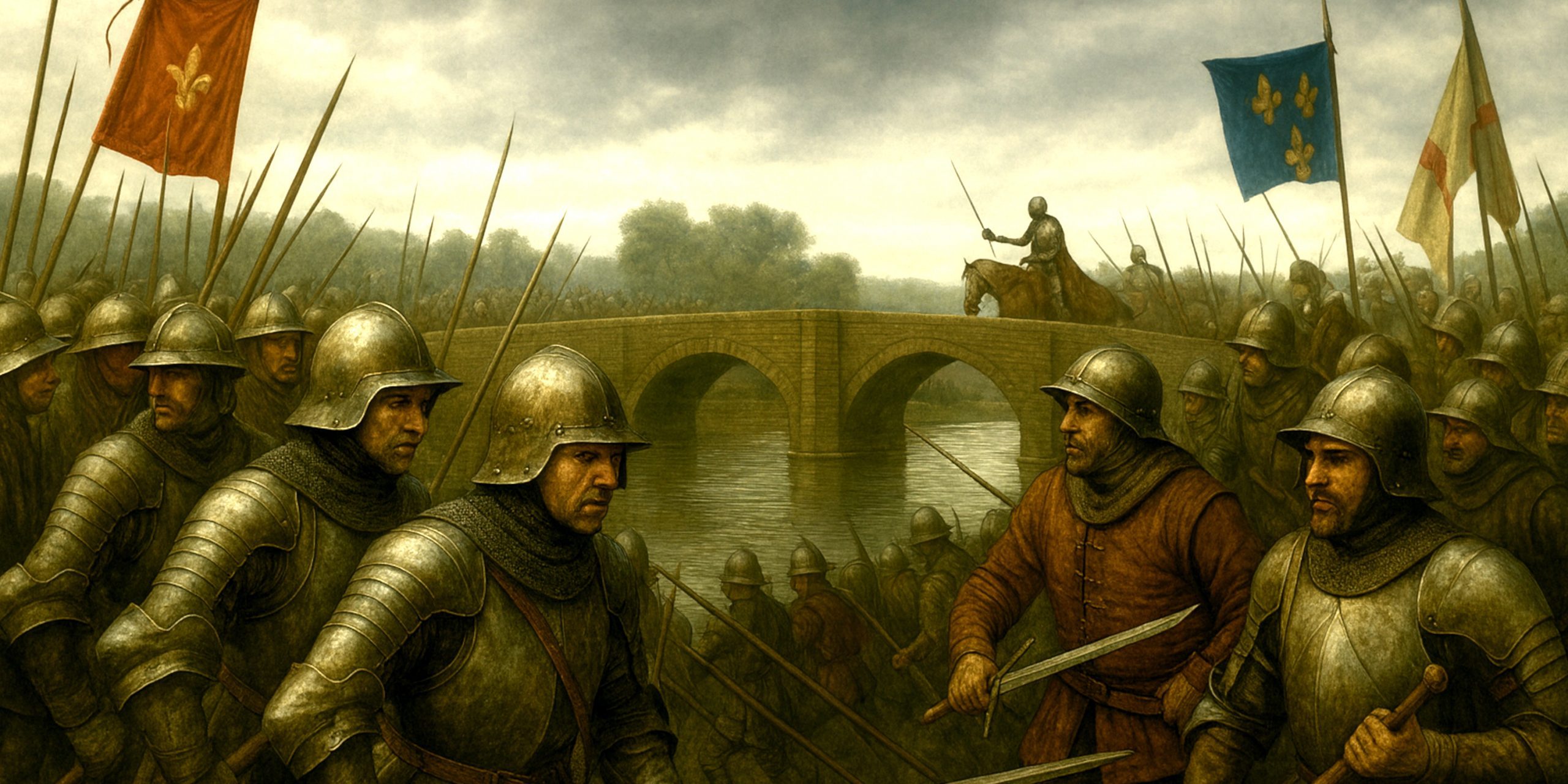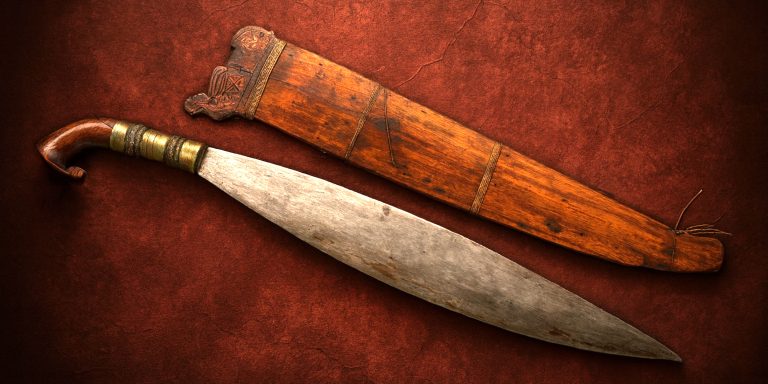
The Battle of Ludford Bridge was not so much a clash of swords as a collapse of nerve. Fought in October 1459 near Ludlow, on the Welsh border, it was one of the least bloody but most consequential moments of the Wars of the Roses. Yorkist ambitions came apart not through defeat in combat, but through the disintegration of trust, the flight of leaders, and the fickle loyalty of an unpaid army. What followed set the stage for exile, retribution, and the eventual resurgence of the House of York.
Background
After the uneasy peace following the First Battle of St Albans (1455), the realm drifted toward open war once again. The Duke of York’s faction, emboldened by a sense of divine right and parliamentary legitimacy, gathered forces at Ludlow. The Lancastrian court, led by Queen Margaret of Anjou, responded by mustering a far greater royal army.
The Yorkists were in a precarious position. Their propaganda had always claimed loyalty to King Henry VI, but it was difficult to reconcile that claim while pointing cannons at him. When the royal standard appeared under the pious and bewildered monarch himself, morale among the Yorkist ranks faltered.
Forces
| Side | Commanders | Estimated Strength | Composition |
|---|---|---|---|
| House of York | Richard, Duke of York; Richard Neville, Earl of Salisbury; Richard Neville, Earl of Warwick | c. 10,000–12,000 | Retainers from the north and the Welsh Marches, mercenary archers, men-at-arms, and Warwick’s Calais contingent |
| House of Lancaster (Royal Forces) | King Henry VI; Queen Margaret of Anjou; Jasper Tudor; Henry Beaufort, Duke of Somerset | c. 20,000–25,000 | Royal household troops, northern levies, loyal magnates’ retainers, and royal artillery train |
York was outnumbered roughly two to one, but more importantly, his army’s heart was not in it.
Arms and Armour
The men at Ludford Bridge were well-equipped by the standards of the day, particularly Warwick’s veterans from Calais.
Yorkist Weaponry:
- Swords: Oakeshott Type XV arming swords, designed for thrusting through plate gaps.
- Polearms: Billhooks and glaives, favoured in English levies.
- Bows: The longbow remained the decisive English weapon, though few arrows flew that day.
- Armour: Transitional harness combining brigandines and plate; some full plate for men-at-arms.
Lancastrian Weaponry:
- Swords: Type XVIa longswords and falchions among men-at-arms and knights.
- Polearms: Bills and halberds.
- Artillery: Royal cannon were present but unused.
- Armour: Standard 15th-century English plate with sallets and bevors, supplemented by padded jacks among the levies.
In truth, both sides were armed for war, but only one side intended to fight it.
The Battle (or Lack Thereof)
On the night of 12 October 1459, the Yorkist forces occupied positions around Ludford Bridge, a strong defensive position over the River Teme. The royal army, bolstered by the presence of the King himself, advanced methodically. As darkness fell, Henry’s heralds proclaimed royal pardons for those who would desert York and return to obedience.
The turning point came not through combat but betrayal. Warwick’s Calais troops, veterans hardened by years of professional campaigning, refused to take the field against the King. Led by Andrew Trollope, they defected under cover of darkness, taking the Yorkist battle plans with them.
By dawn, York’s camp was in disarray. The Duke himself fled north to Ireland, Salisbury and Warwick to Calais. The Yorkist army melted away without resistance. Ludlow was looted by royal troops, an act that did little to improve Lancastrian reputation among the locals.
Archaeology
Archaeological evidence from Ludford Bridge is sparse, which is fitting for a battle that never properly happened. Surveys around Ludlow have found fragments of 15th-century arrowheads and buckles, but no mass graves or significant concentrations of weaponry. The absence of destruction layers supports the written record: the engagement dissolved before blood was spilled.
Local finds from Ludlow Castle, however, include fragments of mid-15th-century harness fittings and coins dating from the reign of Henry VI, hinting at the temporary military occupation of the site during the Yorkist mustering.
Battle Timeline
- Early October 1459: Yorkist forces muster at Ludlow; Lancastrian forces gather near Worcester.
- 10–11 October: Both armies move toward Ludford; York establishes a defensive position.
- 12 October (Evening): Royal army approaches Ludford Bridge; Henry VI’s presence confirmed.
- 12 October (Night): Warwick’s Calais troops defect to the King; panic spreads in the Yorkist camp.
- 13 October (Morning): York, Salisbury, and Warwick flee; Yorkist camp collapses.
- 13–14 October: Royal forces occupy Ludlow; plunder and disorder reported.
- Aftermath: Parliament of Devils at Coventry (November 1459) condemns Yorkist leaders for treason.
Contemporary Quotes
From Gregory’s Chronicle:
“The Duke of York fled into Ireland in the night, and the Earl of Salisbury and the Earl of Warwick took the sea with haste… The King’s host entered Ludlow and took much good, and left the town bare.”
From The English Chronicle:
“The commons that had been with York were sore afraid when they saw the King’s banner, and many fled ere the morn.”
As one chronicler later observed dryly, “It was a battle without blows.”
The Seven Swords Takeaway
Ludford Bridge was a humiliation rather than a disaster for York. The collapse of his army forced him into exile, yet the leniency shown by Henry VI was soon undone by Margaret’s hardline policies. The subsequent attainders and confiscations, formalised in the Parliament of Devils, radicalised York’s faction. Within a year, they would return in force, their reputations burnished by exile and vengeance.
The battle is a reminder that the Wars of the Roses were as much about loyalty and perception as swordplay. It was not the superior blade that won the day, but the royal standard and a promise of pardon. As a historian might mutter over his ale, “Sometimes the sharpest weapon in war is a pay packet with the King’s seal on it.”
Watch the documentary:



